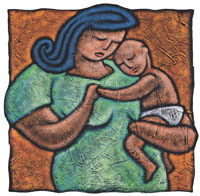Viral
Load, HIV Status, but not IL28B Predict Perinatal HCV Transmission
SUMMARY
Women with higher HCV viral load and those coinfected with
HIV were more likely to transmit HCV to their babies in a
recent Spanish study. IL28B gene pattern did not affect transmission
directly, but babies with the favorable CC pattern more often
spontaneously cleared HCV. |
By
Liz Highleyman
 It
is well known that mothers with hepatitis
C virus (HCV) can transmit the disease to their babies during
pregnancy, delivery, or breast-feeding but the timing and risk
factors for vertical transmission are not fully understood.
It
is well known that mothers with hepatitis
C virus (HCV) can transmit the disease to their babies during
pregnancy, delivery, or breast-feeding but the timing and risk
factors for vertical transmission are not fully understood.
As described in the March
16, 2011, advance online edition of Hepatology, Ángeles
Ruiz-Extremera from San Cecilio University Hospital in Granada
and colleagues analyzed the role of HCV viral load, IL28B, and
other factors in mother-to-child HCV transmission.
Researchers first reported in 2009 that variations in the human
genome near the IL28B gene can help predict outcomes among people
with hepatitis C. Each individual carries 2 copies of every gene,
1 from each parent. People with 2 copies of the protective "C"
gene variant at the rs12979860 location (known as CC) are more
likely to spontaneously clear HCV and respond better to interferon-based
therapy. People with the TT pattern have the worst outcomes,
while those with the CT pattern fall in between.
In the present analysis, investigators enrolled 145 pregnant women
between 1991 and 2009; 112 women (who collectively gave birth
to 142 children) had detectable HCV RNA viral load, while 33 women
(who had a total of 43 children) were HCV antibody positive --
indicating prior infection -- but had undetectable HCV viral load.
IL28B gene patterns were determined for both mothers and children.
Children were tested for HCV RNA at birth and at regular intervals
until age 6 years. HCV vertical transmission was assumed if a
child tested positive for HCV RNA in 2 subsequent blood samples.
Results
 |
19
of the 31 mothers (61%) with the IL28B CC pattern had detectable
HCV viral load, compared with 56 of 68 mothers (82%) with
non-CC (that is, either CT or TT) patterns. |
 |
26
of 128 infants (20%) born to HIV negative women with detectable
HCV RNA acquired HCV infection, but only 9 (7%) became chronically
infected. |
 |
The
rate of HCV vertical transmission was higher among mothers
with higher HCV viral load. |
 |
No
HCV vertical transmission was observed from women with undetectable
HCV RNA. |
 |
Women
coinfected with HIV were much more likely to transmit HCV
to their babies, with a transmission rate of 43%. |
 |
Neither
the mother's nor the child's IL28B status was associated with
an increased likelihood of HCV vertical transmission. |
 |
Children
with the CC pattern, however, were more likely to clear HCV
without treatment, as were those with HCV genotypes other
than 1. |
 |
In
a multivariate analysis, a child having the favorable CC pattern
was the only predictor of clearance of genotype 1 HCV. |
Based
on these findings, the study authors concluded, "High maternal
viral load is the only predictive factor of HCV vertical transmission."
"IL28B plays no role in HCV vertical transmission,"
they continued, "but IL28B CC child polymorphism is associated
independently with the spontaneous clearance of HCV genotype 1
among infected children."
"Our data are the first to account for HCV virus clearance
and may provide important information about protective immunity
to HCV," Ruiz-Extremera said in a press release issued by
Hepatology publisher Wiley Blackwell. "Further investigation
is needed to understand the mechanisms involved with this genetic
variation and the clinical impact of the IL28B variant on HCV
infection."
Investigator affiliations: San Cecilio University Hospital,
Granada, Spain; Centro de Investigacion Biomedica en Red de Enfermedades
Hepaticas y Digestivas (Ciberehd), Granada, Spain; La Paz Hospital,
Madrid, Spain; Department of Medicine, Granada University, Spain.
4/29/11
Reference
A
Ruiz-Extremera, J Munoz-Gámez, MA Salmerón-Ruiz,
et al. Genetic variation in IL28B with respect to vertical transmission
of hepatitis C virus and spontaneous clearance in HCV infected
children. Hepatology (abstract).
March 16, 2011 (Epub ahead of print).
Other Source
Wiley Blackwell. Severity of hepatitis C and HIV co-infection
in mothers contribute to HCV transmission to child. Media advisory.
April 27, 2011.
